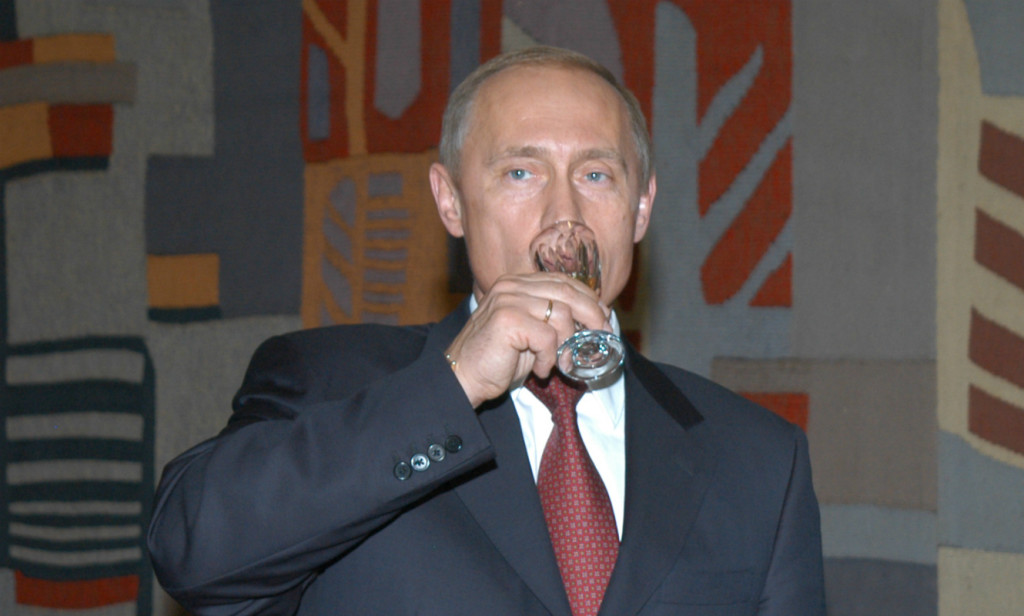Sanctions & Booze in Putin’s Russia

As a Russian, there are certain — shall we say — “nuances” when family from overseas visits. In my family, that nuance (up until recently) revolved around the purchase of iPads, which are cheap in the states compared to their price in rubles. However, over the last year, that dynamic changed. Instead of taking my uncle to the nearest Apple store upon his arrival in the states, I took him on a search for Four Roses Single Barrel bourbon.
Russians, despite what they may say about the West or what we think they may be saying, love Western products. In many cases, as my uncle proved, ownership is a sign of wealth, and, most importantly, power through access. Never is power through access more important, and more evident, than in a restrictive environment. And there are few restrictive environments as obvious as current-day Russia.
My colleague Jake Hall detailed in his article that alcohol, primarily vodka, plays a worrying role as an instrument of “power, policy, and state finance in Russia.” Alcohol consumption in Russia has evolved since late 2014, when a presidential decree mandating Russian counter-sanctions on Western nations went into effect. Russian drinking habits have gradually begun to resemble those of a society facing a harsh economic reality, but not in the way you might expect.
Though Russia continues to lead the world in alcohol-related deaths, alcohol consumption in sanctioned Russia is undergoing a pivot. On one hand, this pivot simultaneously supports the “if–then” Kremlin logic that if sanctions are effective then domestic producers can exploit the gaps left behind by expensive western booze, while also highlighting the destructive grip alcohol has on Russian society.
Russian alcohol production over the past 14 months has increased primarily in one area: wine. In fact, according to the Russian Federal State Statistics Service (Rosstat), in the first half of 2015, wine, along with beer, increased its share of total alcohol production, but was the only alcoholic product in which sales retained a positive trend. The increase in both production and consumption of Russian wine is astounding not only for the rate of its growth (by January 2015, Russian wine constituted 75 percent of in-country market share), but also for the fact that until recently Russia was one of the top-five largest importers of wine worldwide.
As with most industries in Russia, the government has played a role in domestic wine’s growing popularity. On April 16, 2015 the head of the Crimean Republic, Sergei Aksenov, announced that 650 million rubles ($10.2 million) from Russia’s federal budget would be allocated to the development of Crimean vineyards and gardens in 2016. Additionally, the Crimean Minister of Agriculture, Vitaly Polishchuk, stated that 600 hectares of vineyards would be developed concurrently. Likewise, the wine-producing regions of Rostov and Krasnodar Krai, both of which are located near the Black Sea, have received support from the state. The increase of domestic wine production has, in some small part, validated Russian claims that product sanctions are actually a good thing; so much so that Russian Agriculture Minister Alexander Tkachyov claimed on June 24 that Russia would be able to replace most imported wine with domestic variants by 2020.
Despite the strong rate of growth, concerns persist that the Russian wine industry lacks sufficient regulation and investment to maintain its current growth spurt. Fears that patriotic sentiment following Russia’s annexation of Crimea will wane in the future may also adversely affect the lure of domestic wine.
While the longevity of Russian wine remains to be seen, other alcohol producers have pushed forward with attempts to produce domestic versions of foreign imports. Soyuzplodoimport, manufacturer of Stolichnaya vodka, announced plans on June 8 to produce whiskey made entirely of Russian ingredients under the Stolichnaya brand. Priced at between 600 and 650 rubles ($9.50–10.20) for a 750ml bottle, the Stolichnaya whiskey and others like it are meant to undercut foreign imports.
Pricing is not the only distinguishing factor for Russian-produced alcohol. In an attempt to make domestic versions of foreign favorites stand out even more, the Russian Federal Service for Alcohol Market Regulation presented draft regulations on July 14 to place special federal stamps on alcoholic beverages such as brandy, sparkling wine, and hard liquor produced in Russia.
Though domestic production of wine (and possibly whiskey) has helped to partially alleviate the high cost of imports, more and more Russians are finding that even vodka is becoming inaccessible due to the slumping economy. Instead, moonshine is gaining in popularity: Monthly revenues in 2015 from retail moonshine have increased to 5–6 million rubles ($79–95,000), up from 3–4 million rubles ($48–63,000) at the end of 2014. Furthermore, demand for even cheaper illegally produced alcohol also appears to be on the rise. On June 17, authorities near Moscow seized 58,000 liters of bootleg vodka and cognac.
Regardless of how long sanctions remain a part of everyday life for Russians, one thing is certain — alcohol will always play a part. Furthermore, as long as that remains the case, access to brand-name booze (especially from outside of Russia) will remain a sign of stature. In many cases, Russians have even cut out the middleman to get their fix. Since the start of 2015 the sale of distilleries and distilling equipment in Russia has increased by 200–300 percent. Despite this recent trend towards homebrew, however, all signs point to my uncle and I going on the hunt for fine bourbon in the future.
Ruben Gzirian is a pursuer of fine whiskeys, with Michter’s US*1 American Whiskey currently his favorite. He holds an MA from the Monterey Institute of International Studies and enjoys reading World War II history, with a focus on the Eastern Front.
Photo credit: Antoniorosset

